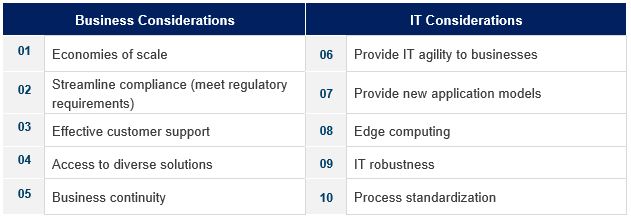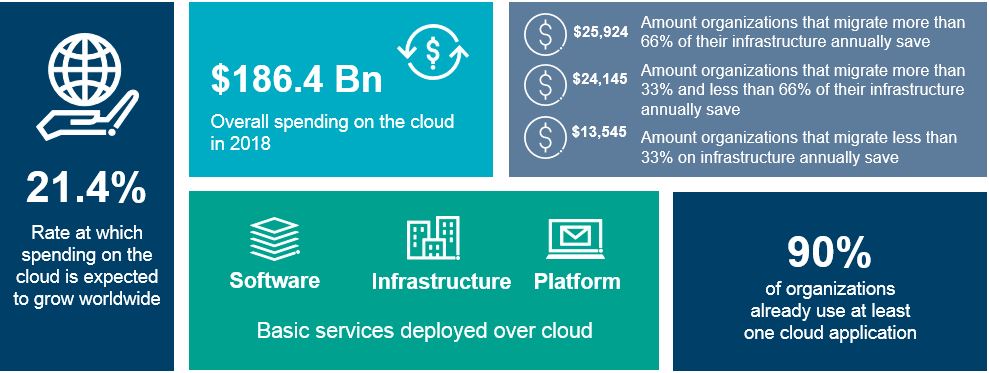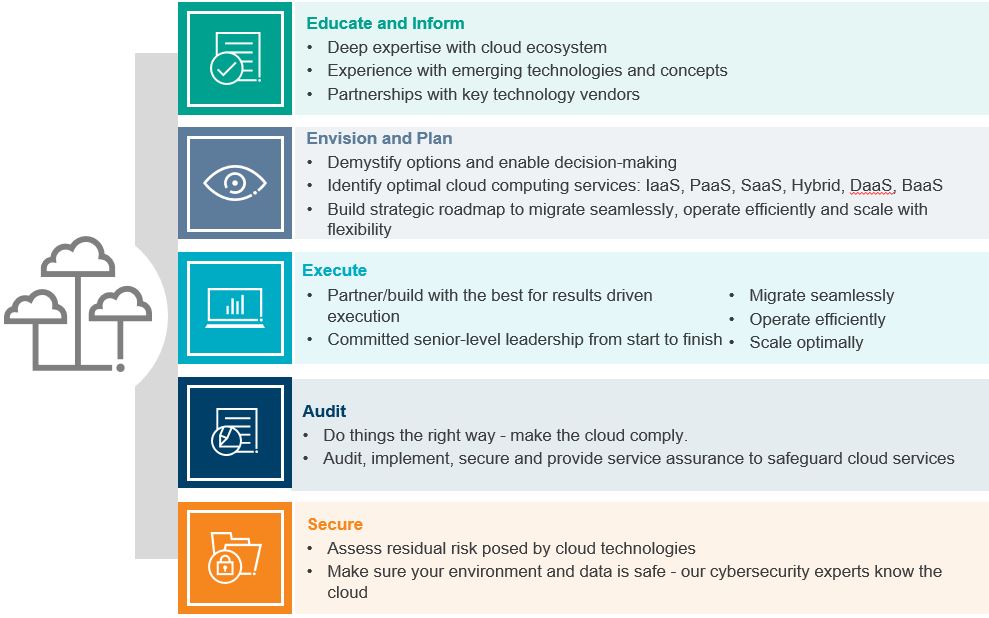How Has the Cloud Evolved?
Cloud started as a peripheral technology option, offering companies and individuals convenience and flexibility at the cost of control and security. As time has passed, however, cloud technologies have matured and become more robust, secure, controllable and flexible.
This evolution has been possible due to growing consumer needs. What’s fascinating is how cloud technologies have not been restricted to the technology sector. Some of the best advancements have been seen in financial services, healthcare, consumer products, manufacturing and distribution, energy and utilities, and government sectors.
The surge of the cloud in the healthcare sector is so significant that Microsoft is making efforts to create cloud-based patient profiles and use artificial intelligence to analyze data.
Is It Time to Move to the Cloud?
To help determine whether the time is now, we recommend that companies be vigilant for 10 general signs. Typically, these become apparent when one or more of them align with an enterprise’s strategic business objectives. Viewed collectively, these signs indicate the necessity of moving to the cloud in order to remain relevant as a business enterprise because change is imminent; otherwise, the risk of disruption increases significantly. Every company must view itself as a digital competitor in today’s rapidly evolving business environment.
Top 10 Signs It’s Time for Your Company to Move to the Cloud

Business Considerations for Moving to the Cloud
- Economies of Scale: By reducing a company’s investment in maintaining infrastructure and sharing resources among users due to deployment of multi-tenancy solutions on single hardware, the cloud helps generate economies of scale through cost savings and resource optimization. Therefore, businesses unable to maintain profits because of continuous heavy investment in tools and software should consider moving to the cloud.
- Streamline Compliance: Regulatory requirements such as PCI DSS, the Gramm-Leach-Bliley Act and the General Data Protection Regulation have a huge impact on the overall business, especially in financial organizations. Hyperscale cloud providers and third-party managed service providers offer services that automate tagging and data-classification processes, making it easy to understand data and identify location. Businesses suffering from the pressure of meeting compliance standards should consider switching to the cloud.
- Effective Customer Support: The cloud provides customers with a smooth online experience and enables businesses to offer 24/7 customer support through access to demanding information from anywhere at any point of time. If a business is not able to effectively support its customers or provide required information in times of crisis, it is time to consider the cloud.
- Access to diverse solutions: Software for artificial intelligence, blockchain, data mining, the Internet of Things (IoT) and so on is available at minimum investment for an organization deployed on the cloud. Businesses constrained by a variety of software and services to deliver valued output should consider this challenge as a sign to move to cloud computing.
- Business Continuity: The cloud is an ideal backup environment for organizations, as cloud computing operates on virtualization technology. In case of a disaster, this technology enables quick recovery of data and applications in the remote data center (the cloud). Hence, the cloud is becoming a popular option for enterprise disaster recovery.
IT Considerations for Moving to the Cloud
- Provide IT Agility to Businesses: Companies can leverage the cloud to deliver high-value activities consistently and encourage continuous innovation in accordance with changing business requirements. In fact, according to a survey* of 300 influencers, 62 percent of them think employing cloud computing is a very important step toward attaining IT agility. IT organizations lagging in product innovation and changing needs should consider shifting to the cloud.
- Providing New Application Models: Cloud computing supports new application models such as containers, the actor model and serverless computing. Containers provide better utilization of hardware and help enable legacy applications to move to the cloud, serverless computing assists in evolving to a modular model where one pays only for what one is using, and the actor model extracts infrastructure concepts that help manage a large number of IoT devices. IT organizations can leverage these new technologies and enhance the efficiency of their work cycle by making a move to the cloud.
- Edge Computing: Edge computing helps IT organizations achieve faster data analysis, and, significantly, a large amount of information can be handled on-site or at the edge, reducing the total bandwidth required.
- IT Robustness: Cloud security has occasionally been brought into question due to data breaches (in the case of Equifax, Verizon, Anthem, etc.) that have resulted in huge losses for big companies. However, an article* from Gartner states that through 2022, at least 95 percent of cloud security failures will be caused by customers and that in 2018, 60 percent of enterprises that implement appropriate cloud visibility and control tools will experience one-third fewer security failures as a result of better testing strategies implemented by cloud vendors. IT organizations still implementing primitive on-premise infrastructure and subject to regular breaches should consider switching to the cloud.
- IT Process Standardization: With the help of cloud computing, IT processes implemented in an organization can be streamlined and certain best practices and benchmarks can be established throughout the organization. IT organizations unable to tap their process flow and consistently required to alter their IT process environment to make things work should consider cloud adoption as a top priority.
The Largest Obstacle to Cloud Transformation
Cloud computing enables new business models and is now trusted by most organizations and by regulators. Many companies have embraced adoption of the cloud model and as a result have been able to deliver sustainable results.
However, for legacy companies, transforming to a cloud model presents several obstacles.
In a survey*, 450 IT leaders consistently shared the skills transformation required to make the move to the cloud as their top priority. One of the major factors preventing companies from successfully adopting this paradigm shift to the cloud is that they are not taking the level of talent transformation required seriously.
According to a report* on the cost of cloud expertise, out of 950 IT decision-makers:
- 39% expect to see positive ROI in future.
- Only 48% report a positive return on investment by migrating their IT infrastructure to the cloud.
- 71% of IT decision-makers say their company has experienced a loss of revenue at some point of time due to lack of cloud expertise.
This clearly shows the common contradiction we see between stated business goals and the actual transformation approach taken. Although many companies are correct in believing that cloud expertise is a must to remain competitive in their business environment, it is clear they are not fully embracing either the need to partner with firms with cloud expertise or invest internally to close this talent gap to reinvent their culture rapidly enough.

Source: Gartner, Mindshift, Statista, Stratosphere
Protiviti’s Unique Cloud Approach
Protiviti is a global consulting form that delivers deep expertise, objective insights, a tailored approach and unparalleled collaboration. We provide consulting solutions in finance, technology, operations, data analytics, governance, risk and internal audit to our clients. With our full consulting capabilities, we can be your comprehensive and trusted cloud partner to:

*Resources:
– Cloud Vision 2020: The Future of the Cloud Study, LogicMonitor
– Gartner Survey Says Cloud Computing Remains Top Emerging Business Risk, Gartner
– The Cost of Cloud Expertise, Rackspace





